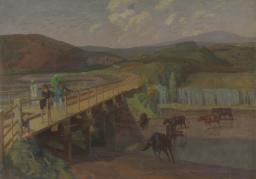Author unknown, ‘The Camden Town Group’
Morning Post, 17 December 1912.
The Camden Town Group.
A few years ago Camden Town was known chiefly as a place through which ’buses ran to Hampstead and Highgate. But a group of artists now take its name, the reasons why we do not know. Judging by their work they might have hidden their identity quite as well under the name of the Clapham, Hoxton, Kensington Group. There is nothing about the pictures on show at the Carfax Gallery, Bury-street, to associate their painters with any of the places mentioned. Mr. Wyndham Lewis is the one disturbing member of the “group.” His admirers even confess that they do not altogether understand his motives from their presentation. They are inclined to think that he does suggest motion in the “Danse” (25). To the normal vision a falling, wind-driven aeroplane would with far greater consistence describe, in Mr. Lewis’s own terms, the convolutions of a dance. The people in a wrecked aeroplane in descent would assume an appearance of disintegration, as if they were parts of the machine. But the heads in the “Danse” remain rigid and realistic. There is no room for doubt. The cyphers to which we refer are really meant to be human heads. And in this direction lies Mr. Lewis’s way of salvation – that is, if he has any artistic talent. We have greater hope for the intelligence of posterity than to believe that they will find aesthetic or intellectual pleasure in things like the “Danse.” A penny mechanical toy in the hands of a child could be far more potent than the ordered disorder of No. 25 at the Carfax.
To turn from this canvas to the work of Mr. Walter Bayes we pass to construction of another kind. All art depends more or less on conventional structure, particularly imaginative or decorative art. But the duty of the artist is to hide as far as possible the means employed in erecting his pictorial masonry. Mr. Bayes fails to do this mainly in the “Port” (37). His chief interest in the various figures and objects is decorative. The man, the woman, and child are considered not so much as human beings but as connecting links in an [?obvious] rhythm of line and colour; the trees bend or stiffen and the river turns in its service. Of course the picture has a certain beauty, but it lacks impulse. “Le Petit Casino” (35) and the “Shade” (36) are less apparently deliberate and more charming in colour. Yet we miss the instinctive acceptance of fundamental truth, the regard for character as a factor in design. The woman in “Le Petit Casino” arouses no human interest. She merely supplies agreeable notes in an excellent harmony. The most distinctive feature of these three pictures are the suggestion and the quality of shade corresponding to the light in 36. Here fundamental truth has not been sacrificed at the altar of decoration, though the green tub must have cost considerable debate. Mr. Bayes is one of the most brilliant of our younger men, and his work would gain immensely if he would allow his intellect to more frequently enjoy a “fling” with his emotions. No other painter exhibiting is more respectful of his technical accomplishment than Mr. Bayes. Mr. Walter Sickert is more consummate in knowledge, but his temperament, like that of “Phyllida at the Fair,” is somewhat contemptuous and often brings regret to the lips of his admirers. “Chicken” (33) offends less in this respect.
Mr. W. Ratcliffe, who is new to us, has a clear, untrammelled vision and considerable adaptability of expression. Mr. J. B. Manson improves in a pleasant normal fashion. “Moonlight and Snow” (8) has mood, and it is conveyed with fluency and feeling. Mr. J. Doman Turner’s drawings are joyous; as for the rest they offer little incentive to praise or blame.
In the same gallery are clever but distraught sketches by Mr. Charles Freegrove Winzer and a case of extremely beautiful miniatures by Miss Cushla Parker.
How to cite
Author unknown, ‘The Camden Town Group’, in Morning Post, 17 December 1912, in Helena Bonett, Ysanne Holt, Jennifer Mundy (eds.), The Camden Town Group in Context, Tate Research Publication, May 2012, https://www

